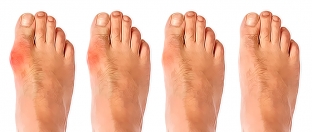Many people suffer from the discomfort associated with thumb bursitis for many years. It is more popularly known as a "bump" or bone that appears on the thumb and interferes with the normal wearing of shoes. Today we will tell you in detail about this problem and how to treat it.
What is thumb bursitis
Near each of the joints there is a periarticular sac called a bursa. It contains synovial fluid. It helps the joint slide during movement, softens the friction of the ligaments and bones, reducing pressure on the bone.
If excess fluid accumulates in the synovial sac, this can lead to bursitis - inflammation of the bursa. The appearance of a seal provokes constant irritation in the region of the first phalanx of the thumb. Gradually, this very seal moves the bone, and a bump forms at the site of the shift.
The main causes of thumb bursitis are:
- weakness of the joint and its excessive mobility;
- flat feet;
- diseases of the joints;
- Thumb injuries.
Less commonly, bursitis due to other causes:
- metabolic disorder;
- joint infections;
- allergies;
- congenital deformities of the foot;
- inflammatory processes in tissues;
- intoxication.
The main cause of bursitis is considered too tight shoes. In fact, shoes cannot be the root cause of the disease, it can only provoke the process of its development. This explains why women suffer from bunions more often than men, as narrow heeled shoes create ideal conditions for the development of the disease.
Risk groups
There are several risk groups that can develop bursitis:
- People who are on their feet a lot. This is especially true for ballerinas who spend many hours rehearsing, dancing on their fingers.
- Elderly people. They have bursitis of the thumb 5 times more common than young people.
- Hereditary predisposition.
Symptoms of disease
Here are symptoms that may indicate bursitis:
- a lump forms on the big toe;
- when walking there is a feeling of sharp pain;
- difficult to put on shoes;
- Corns appear on the seal.
Because these symptoms are easy to spot, thumb bursitis can be managed at an early stage. But it is worth contacting a specialist, undergoing a study to confirm the diagnosis and get recommendations for treatment. Be aware that these same symptoms can be a sign of other conditions such as arthritis or gout.
Treatment of bursitis
If the diagnosis has confirmed the disease, then it is worth proceeding to its immediate treatment. The treatment of bursitis consists of several procedures.
Usually doctors prescribe:
- anti-inflammatory drugs;
- exclusion of loads on the leg;
- fixation of the joint with plaster;
- after acute inflammation is relieved, UHF therapy is prescribed;
- when forms are running, the – bursectomy.

Bursitis Prevention
To prevent thumb bursitis you need:
- When buying shoes, make sure that they do not squeeze your fingers.
- Do not wear heels or tight shoes if you have to spend a lot of time on your feet.
- Do not overload your legs.
Thumb bursitis – problem to be treated. Remember, to avoid its occurrence, it is worth resorting to prevention. We hope that our article was useful for you!
Source estet-portal.com








Add a comment